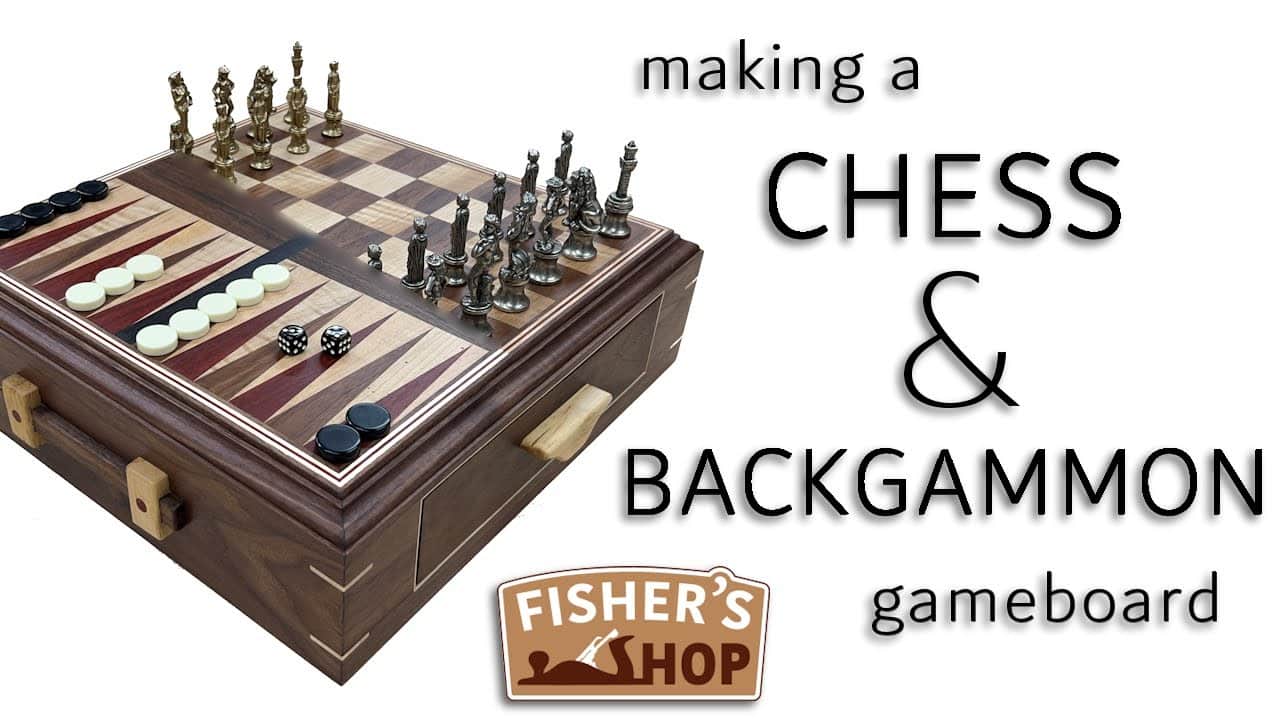This project was built and designed by Drew Fisher from Fisher’s Shop.
The build is a reversible gameboard that hides a backgammon surface beneath a chessboard within a walnut box featuring a drawer for pieces and finger grips for portability.
The piece mixes bold contrasts—black walnut with curly maple and bright accent woods—and combines decorative trim with functional storage for a showpiece that is meant to be used, not just admired.
Watch the full video and subscribe to Fisher’s Shop:
Design
The design centers on a reversible playing surface: chess on one side, backgammon on the other, set into a box with a drawer that stores pieces and offers organized compartments.
Decorative elements—split trim, finger grips, and splines—add visual interest while the box remains practical and portable.
The aesthetic relies on contrast and symmetry, pairing dark walnut with light curly maple and small inlays of vivid accent woods to make the playing surfaces pop.
Thoughtful proportions and a raised board inside the box keep the visual balance and provide the right playing height.
Lumber Prep
Lumber was flattened and milled into workable strips, then cut and arranged to create a checkerboard of alternating light and dark squares for the chess side.
Grain matching and careful layout ensured the seams read cleanly when the panel was assembled and trimmed.
For the backgammon side, small triangular points were produced from square stock using a dedicated sled and a pair of jigs to get repeatable angles and lengths.
The builder emphasized batch cutting and test-fitting to keep the pattern precise across the board.
Joinery & Assembly
Panels were glued up in stages: laminating strips into wider panels, resawing and reorienting pieces to create the chess pattern, and assembling backgammon quadrants before joining them with thin spacers and a center bar.
Clamping jigs held pieces square while glue cured to prevent bowing or misalignment.
Corner strength and visual detail came from splines cut into the mitered box edges, and box joints were used for the drawer sides to provide both durability and a decorative touch.
Drawer slides and a custom-shaped pull were fitted to allow smooth operation and a comfortable grip.
Trim, Drawer & Hardware
Thin laminated trims were stacked and mitered to frame the playing surface, creating a layered pinstripe effect that conceals panel edges and enhances the overall look. The box body was assembled with routed rabbets for a removable bottom and internal risers to set the playing board at the correct height.
The drawer was organized with fitted trays and dividers to keep chess and backgammon pieces separated, plus a dedicated rolling area for dice.
Finger grips on the sides were carved and fitted with colored plugs for a strap-and-buckle visual cue that also aids handling.
Flocking & Interior Details
The drawer interior received a flocked finish to create a soft, velvety bed for game pieces; adhesive was applied and short fibers were dispersed to produce a cushioned surface that reduces noise and wear.
Excess fibers were removed and the sections were cleaned with compressed air to leave a neat, even coverage.
Small trays for checkers and dedicated compartments were sized to prevent pieces from sliding during transport, and lightweight stops were used to maintain layout while the adhesive cured. These interior choices prioritized usability and protection for the components.
Finishing
The final finish was an oil-and-wax approach that brings out wood color and figure while leaving a smooth, durable surface that invites use.
Multiple thin applications allowed the oil to penetrate before the wax sealed the surface, and buffing produced a glassy hand feel without a heavy film finish.
Edges and splines were sanded through fine grits to blend joints and trim, and final assembly proceeded after finishing to protect exposed surfaces from handling wear. The result is a tactile, long-lasting finish that complements the contrast of the woods.
Lessons Learned & Shop Tips
Small-shop lessons emerged during the build: use push blocks and supporting jigs when ripping narrow strips to prevent burning, gaps, and safety issues when pieces shift.
Spotting a problem early—like a burn causing a seam gap—saved time overall by prompting a redo rather than forcing a compromised assembly.
Jigs paid dividends for repeatable cuts (especially the triangular points for backgammon) and clamping fixtures kept panels flat while glue dried. Simple retrieval tricks for tiny offcuts and a habit of test-fitting before final glue-up reduced rework and improved the final fit.
Conclusion
The project demonstrates how careful material choices, repeatable jigs, and thoughtful interior organization can turn a traditional gameboard into a practical, elegant object built for regular use.
The reversible board, refined trim, and cushioned storage balance form and function while showcasing contrasting woods and precise joinery.
Get Drew’s plans here: https://fishersshoponline.com/plans/p/chessbackgammon.
